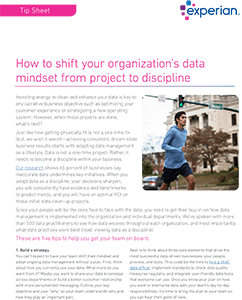1. Build a strategy.
You can’t expect to have your team shift their mindset and adopt ongoing data management without a plan. First, think about how you currently use your data. What more do you want from it? Maybe you want to share your data knowledge across departments or build a better customer relationship with more personalized messaging. Outline your key objective and your “why” so your team understands why and how they play an important part.
Next is to think about three core elements that drive the most successful data-driven businesses: your people, process, and tools. This could be the time to hire a chief data officer, implement standards to check data quality measures regularly, and integrate user-friendly data tools that everyone can use. Once you know your plan on how you want to intertwine data with your team’s day-to-day responsibilities, it’s time to bring the plan to your team so you can hear their point of view.
2. Get the green light from your team.
Your people will be the ones getting their hands dirty with the data, so you need to get their buy-in and insight. Ask your data-users questions like: Will these processes support your data needs? How will you execute using this data? What else do you need from us as the data advocates? When you have insight to your team’s needs, you can then fill in the gaps in your plan.
3. Fill in the gaps.
After speaking with your team, you will get a better idea about where the gaps are between your initial plan and what your team wants. One factor that could come up is what the shift in data ownership will look like. According to our research, 58 percent of respondents say data management primarily sits with IT, while 42 percent report that it primarily sits with business users. When you implement ongoing data management practices, who will own your data?
Naturally, if a business is adopting data management and data governance programs, departments will leverage their own data, and IT will manage the more technical side of implementations. However, this approach can become very siloed, so it’s important to standardize some best practices across the business, like increasing communication across business units, integrating data quality tools, and hiring the right people—which are the three main areas you want to invest in when it comes to your data management.
4. Invest in your discipline.
Just like getting fit, data is an investment of time, energy, and money—and it’s worth it. Sixty-one percent of organizations say they have traditionally underinvested in data quality. Yet, when companies invest in their data, most of them see a progress with their data initiatives within the first 12 months.
Since you are striving for data quality maturity, you want to circle back to your data management strategy and see what needs your attention. Maybe it’s time to reinvest in your data quality management tools. Once you implement these tools, expect to see a more holistic view of your data and a deeper understanding of your business. Now you will have the resources needed to track your success.
5. Measure your success.
For your efforts to be embraced by your team, you need to measure your success to prove ongoing data management is worth everyone’s time and energy. Make sure you measure how your new processes and tools are affecting your bottom line.
Imagine this: You’ve implemented data management across your whole organization and your marketing team has really taken the reins on using data to drive their initiatives. Data management has enabled your marketing team to create more personalized campaigns resulting in stronger customer relationships and growth to your bottom line. Data as a discipline gives you the upper hand when looking at trends, allows you to pivot, and ultimately, it gives you the opportunity to hit multiple revenue streams across your business.
We get it, shifting your organization’s mindset from data projects to data discipline is not a walk in the park. But, enabling data across your business will provide a canvas for more creative, data-driven approaches, ultimately resulting in maximum operational efficiency, a foundation for an exceptional customer experience, and more.



